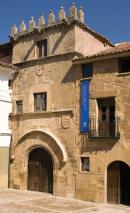Sigüenza. España
Standing as its Own City
Nestled in the north of the Spanish province of Guadalajara, in the highlands of Henares, this medieval city has lived out the ages with a character of its own, leaving behind the traces of some of the most important civilizations in history.
The etymological origin of this city’s name in Castilian-Manchego tongue means the one that dominates the valley. The place name was coined by sheer chance due to its geographical location and to what history has told about it. Dregs harking back to the Iron Age have been found in the outskirts of the city’s current urban core. Arabs, Visigoths and Romans also left their footprints in these lands. During the Middle Ages and thanks to its privileged location, the burg played a major defensive role that prompted the city to recover its condition as Episcopal host. Monumental City Medieval Siguenza has shown vestiges of its history in the indispensable monuments scattered all across the city. Bernardo de Agent, who conquered Siguenza in the 12th century, started to build the city around a couple of main cores. One of them was constructed around the castle, while the ecclesiastic one was built around the cathedral. Perched atop the highest lands of Siguenza, there’s a castle built in the 12th century that served as a palace-fortress and residence of bishops who lorded the city for seven long centuries. The bird’s-eye of the city view from the battlements is just breathtaking. The interiors are dominated by an arms patio with a water-supplying well. In addition, there’s a throne room or Red Hall from where the bishops used to administer justice. The cathedral –also built in the 12th century- is a must-see. It’s known as the “Fortis Seguntina” and features a romantic style, though it was conceived during the Romantic-Gothic transition period. Its three inner naves and the crossing boast five apses in the front of the shrine and a cloister on the north side. La Casa del Doncel, The Diocesan Museum, la Plazuela de la Cárcel, the Church of de San Vicente or the Church of Santiago are other landmarks worth taking a long look at in a city in which visitors will also see baroque, renaissance-style or neoclassic buildings along the way.
Beyond History: Gastronomy and Rest A delicious cuisine can be enjoyed while in Siguenza: roast lamb, crumbs and sausage, rasher of bacon and fried eggs, Castilian soup, game products or pickled trout with ham are some of the treats this region has to offer. And to wrap things up, nothing compares to Doncel yolks and honey-dipped biscotti. The city features a number of good options to stay overnight, depending on the traveler’s needs. The boom of countryside lodgings all across the region will not only provide travelers with a good rest, but will also let them discover different monument-laden routes, landscapes and history for an unforgettable travel experience. Artisans Painters, sculptors, weavers, forgers and artisans. That seems to be a list of professions from an ancient town. However, the striking thing about this Seguntina village and its residents is that many millenary traditions have remained as walks of life of today. The Blasco family, forged in centenary handcrafting traditions, has been manufacturing wine boots since 1899 with natural goatskin and inner layers made of pitch, a resinous product extracted from pinewood or juniper. When cooked at high temperatures, this material becomes watertight. Five generations later, two brothers from this family have taken over the centenary company. Their names are Jesus and Carlos Blasco Hernandez. The making of homemade rugs and the operation of the looms are run by the Tohede family since 1927. Fernando Veiga cast bronze pieces, Mariano Canfran is a rock carver and Carmen Pau makes etchings.






























































